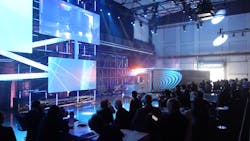DUSSELDORF, GERMANY. There’s general consensus that the connected truck and its path to real-time data will solve many of the trucking industry’s problems, but still to be determined is whether access to that data coming off the connected truck will be in an open format accessible to all or remain tied to proprietary systems developed by truck makers and other providers.
With a pledge this week to invest half a billion Euros by 2020 in developing connected trucks, Daimler Trucks has made its stake in the technology clear. And responding to questions at a press event to announce that commitment, Daimler Truck head Wolfgang Bernhard also took a stand on the question of data access.
“We need open platforms eventually to make connected truck platform valuable to customers,” he said. “We have to open it to everybody.”
The company’s demonstration of its semi-autonomous truck platooning system and an announcement that it was creating a dedicated Digital Solutions and Services department are two indications of its plans to create “always on” trucks connected to the Internet of Things (IoT). That places trucks at the center of transportation networks, sharing information with a broad array of other connected parties to maximize efficiency of the entire logistics chain.
Currently time lost to traffic congestion, waiting at terminals, searching for a place to take rest stops and other unpredictable delays means trucks are only moving freight about 35% of the time, according to Martin Zeilinger, dir. Of advanced engineering for Daimler Trucks. Roadblocks to sharing real-time information among carriers, drivers and customers also result in inefficiencies in planning, leading to empty miles and only partially loaded trailers. “There is a lot of room for improvement,” he said during a day-long press event.
Bringing trucks into a connected IoT environment that is open to all creates transparency for every invested party, whether it be a shipper with a last minute load, a dispatcher looking to balance lanes or a driver looking for a way around traffic.
“The connected truck is always on, always driving, fully loaded, never stuck, never failing and with happy driver,” Zeillinger said. “This is seamless transportation, a great opportunity to address those inefficiencies and to move more freight without adding trucks.”
Calling for “a revolution” with “the truck at its center,” Bernhard predicted a future “where the flow of goods on the road is mirrored by a flow of information in the internet – in real time, where the connected truck is the main data node right at the center.”
About the Author
Jim Mele
Jim Mele is a former longtime editor-in-chief of FleetOwner. He joined the magazine in 1986 and served as chief editor from 1999 to 2017.
